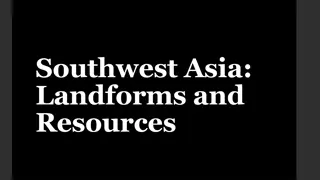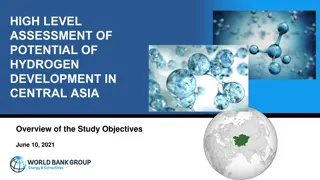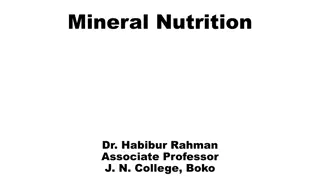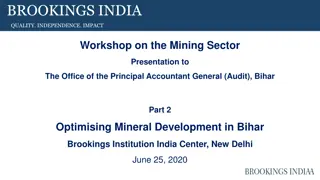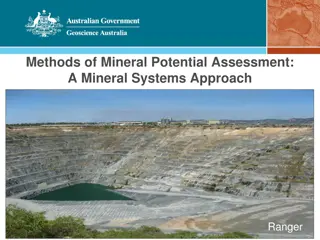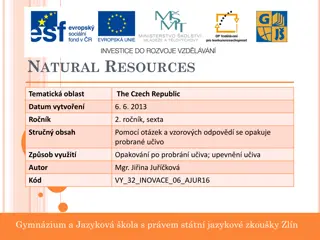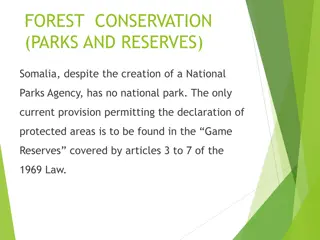Resource Rich Central Asia: Overview of Energy and Mineral Reserves
Central Asia, comprising countries like Kazakhstan, Kyrgyz Republic, Uzbekistan, Turkmenistan, and Tajikistan, is abundant in mineral and energy resources. From vast oil and gas fields to substantial uranium and gold reserves, these nations play a significant role in global resource markets. The region hosts key pipelines like the Kazakhstan-China Crude Oil Pipeline, connecting its resources to major consumers. Hydroelectricity also features prominently, with countries like Kyrgyz Republic leveraging it for a large portion of their energy needs. Tajikistan stands out for its hydropower potential. The resource wealth of Central Asia attracts various external actors keen on tapping into these valuable assets.
Download Presentation

Please find below an Image/Link to download the presentation.
The content on the website is provided AS IS for your information and personal use only. It may not be sold, licensed, or shared on other websites without obtaining consent from the author. Download presentation by click this link. If you encounter any issues during the download, it is possible that the publisher has removed the file from their server.
E N D
Presentation Transcript
CENTRAL ASIA FACT FILE
CENTRAL ASIAN REPUBLICS Kazakhstan The country s enormous mineral deposits make it a world leader in reserves of coal, chromite, lead, and zinc, and its uranium deposits are estimated to be the second largest in the world. Natural gas reserves are substantial as well. Primarily located in the Caspian Sea region, they are found in associated oil and gas fields, such as the giant Karachaganak and Tengiz fields. In 2008, Kazakhstan ranked among the world s top 20 oil producers. Most oil deposits are located in the Caspian Sea region, with the Kashagan field estimated to contain the world s fifth largest oil reserves. Kazakhstan has more than 100 oil-producing fields
CENTRAL ASIAN REPUBLICS Kyrgyz Republic: Hydroelectricity provides the Kyrgyz Republic with more than four- fifths of its electrical energy Uzbekistan: The country counts itself among world leaders in gold and uranium reserves, production, and export. Uzbekistan is also rich in natural gas. Turkmenistan: Its most abundant natural resources are hydrocarbons. Reserves of gas, estimated in 2008 at 9 trillion cubic meters, are the fifth largest in the world. Reserves of oil are estimated at 500 million barrels. Turkmenistan is a major exporter of natural gas, oil, and electricity, mostly to the Russian Federation and Ukraine. Turkmenistan s proven natural gas reserves are also about 100 trillion cubic feet
CENTRAL ASIAN REPUBLICS Tajikistan Tajikistan is rich in mineral resources, including gold, silver, and uranium. As with the Kyrgyz Republic, however, water may be its greatest resource asset. The country s hydro capacity places it among the top 10 nations in the world for hydropower potential
PIPELINES : CENTRAL ASIA Kazakhstan-China Crude Oil Pipeline The 2,798km long Kazakhstan-China pipeline transports crude oil from oil fields located in western Kazakhstan to the Dushanzi refinery located in the Xinjiang Province of China. The pipeline was built to meet China s growing energy needs. It provided a win-win situation for both Kazakhstan and China by directly linking Kazakhstan s huge oil resources in the Caspian Sea with China s strong oil consumer market.
PIPELINES : CENTRAL ASIA AND INTEREST OF EXTERNAL ACTORS Korpeje Kordkuy pipeline The Korpeje Kordkuy pipeline is a 200-kilometre long natural gas pipeline from Korpeje field north of Okarem in western Turkmenistan to Kordkuy in Iran. 135 kilometres of pipeline run in Turkmenistan while 65 kilometres run in Iran. It was built in 1997.
CENTRAL ASIACHINA GAS PIPELINE The Central Asia-China Gas Pipeline began to be constructed in July 2008, and became operational on December 14, 2009. The pipeline starts at Gedaim on the border of Turkmenistan and Uzbekistan, running through central Uzbekistan and southern Kazakhstan, and ends at Horgos in China's Xinjiang Uygur Autonomous Region
CENTRAL ASIA CENTER GAS PIPELINE SYSTEM The Central Asia Center gas pipeline system is a Gazprom controlled system of natural gas pipelines, which run from Turkmenistan via Uzbekistan and Kazakhstan to Russia
RUSSIA DOMINATION ON PIPELINES The Druzhba pipeline is the world's longest oil pipeline and one of the biggest oil pipeline networks in the world. It carries oil some 4,000 kilometres (2,500 mi) from the eastern part of European Russia to points in Ukraine, Belarus, Poland, Hungary, Slovakia, the Czech Republic and Germany.
BAKUTBILISICEYHAN (BTC) PIPELINE The Baku Tbilisi Ceyhan (BTC) pipeline is a 1,768 kilometres (1,099 mi) long crude oil pipeline from the Azeri Chirag Gunashli oil field in the Caspian Sea to the Mediterranean Sea. It connects Baku, the capital of Azerbaijan and Ceyhan, a port on the south-eastern Mediterranean coast of Turkey, via Tbilisi, the capital of Georgia. It is the second-longest oil pipeline in the former Soviet Union, after the Druzhba pipeline. BTC is a major crude oil pipeline that brings Caspian crude to the Mediterranean





